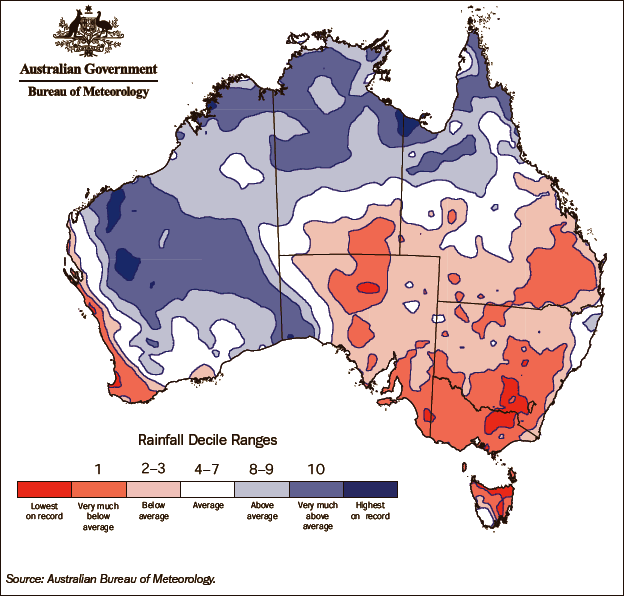FEATURE ARTICLE: 2006 DROUGHT
2006 was an exceptionally dry year in many parts of the south-eastern quarter of Australia, extending north to southern Queensland, as well as in the south-west of Western Australia. The affected areas included the bulk of Australia's population, and most of its cropping areas.
The annual rainfall in 2006 was 40-60% below normal over most of the country south of the Tropic of Capricorn and eastwards from central South Australia, except for most coastal areas which were closer to normal (although still generally dry, except for a few parts of the New South Wales north coast) (map 1.11). The anomalies reached more than 60% below normal over the highlands of southern New South Wales and Victoria, and foothill areas on the north-western side of the highlands. In the south-west of Western Australia rainfall was closer to normal (generally 20-40% below), but still highly abnormal. In contrast, it was a very wet year in many parts of the tropics (mostly falling between January and early April), and in the interior of Western Australia.
When compared with historic records, the most extreme drought occurred in the highlands of south-eastern mainland Australia, and in northern Tasmania. (Both of these are areas which get much of their rainfall from moisture of Indian Ocean origin - so-called 'northwest cloudbands' - a feature almost completely absent in 2006.) Many stations broke all-time records by 100 millimetres (mm) or more. Harrietville, near Bright in north-eastern Victoria, had only 504 mm for the year, breaking the previous record low of 710 mm, while Burnie, in northern Tasmania (408 mm) broke its previous all-time record by more than 260 mm. With the lack of moisture, the alpine snowpack was also at record or near-record thin levels.
As more than 50% of inflows into the Murray-Darling system originate in the New South Wales and Victorian highlands, these exceptionally dry conditions resulted in extremely poor inflows into the basin, with inflows through spring and summer 2006-07 being, in general, only about half the previous lowest on record. With the major storages not having fully recovered from the 2002-03 drought, this made the water supply situation critical by the autumn of 2007.
Record lows were also set in parts of southern Tasmania and along the western coast of Western Australia. For both Perth and Hobart, 2006 was the driest year on record. While it was not such an extreme year elsewhere, rainfall totals were still in the lowest decile in most eastern Australian inland cropping areas (except for northern New South Wales), as well as southern Victoria and South Australia south of Adelaide. While not a particularly extreme year in its own right, 2006 in south-eastern Queensland continued a sequence of successive dry years in the region which have contributed to severe water shortages.
The El Niño event which developed in the second half of 2006 was a significant contributor to the drought, but dry conditions were already well established in much of south-eastern Australia before the El Niño was apparent.
The most acute drought conditions began to ease from early-2007, and many affected areas (southern Queensland being a notable exception) received near- to above-normal rainfall in the first half of 2007. There were major floods along parts of the east coast from southern Queensland to eastern Victoria during the winter of 2007. However, dry conditions returned to South Australia and much of the south-eastern interior from June 2007 onwards, and many major water storages, while above their lows, had only experienced a limited recovery from the conditions of the previous year.
1.11 Australian rainfall deciles - 1 January to 31 December 2006

 Print Page
Print Page